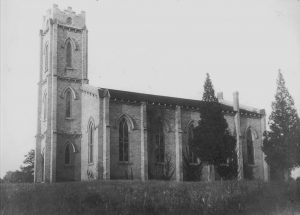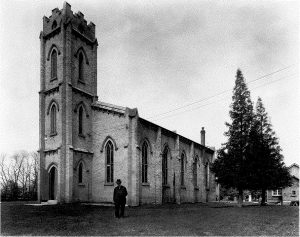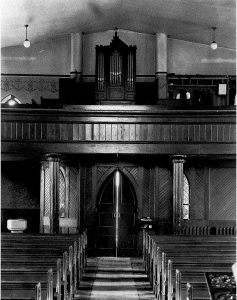St. John’s York Mills Anglican Church, 1816-2016
Copyright © 2015, Susan Goldenberg

The bicentennial is just one year away for St. John’s York Mills Anglican Church, the oldest church in North York and the second oldest in Toronto. The oldest is St. James Cathedral, which is a parish church as well as a cathedral. St. James, at King and Church Streets in downtown Toronto, was started in 1807. St. John’s, located on Don Ridge Drive in the York Mills-Old Yonge Street district, was started in 1816.
Before the church was erected, the area was served with missionaries from St. James. St. John’s began as a 10 by 20 metre frame structure, built by the community from trees felled on the three-acre property, which was donated by Joseph Shepard and his wife. A wood stove heated the building. For the first few years this church and the Friend’s Meeting House in Newmarket were the only places of worship on Yonge Street, a distance of forty miles, as the street extended from the town of York (Toronto) to Lake Simcoe.

St. John’s not only has the distinction of being the first church in North York; it also is well known for its barrel organ, one of only a few of its kind in Canada. Rather than being played by an organist, as a conventional pipe organ is, a barrel organ is operated by a person turning a crank. Pieces of music are encoded on to wooden barrels (cylinders). St. John’s organ has three barrels, each of which contains ten tunes. The organ, installed in 1847, was sent over from England at a cost of £80 10s 6d.
According to the church’s historian, Bill Dennis, the barrel organ was the church’s main instrument until the 1860s, when a small cottage or finger organ was installed. A pipe organ was installed in 1928.
For 69 years ending in 1930, the barrel organ was operated by St. John’s sexton, John Page Squire. He also rang the church bells, tended the graveyard, kept the church in repair and dug graves, until he was in his late eighties. In the days before electricity, he had to take care of two dozen coal oil lamps. He was the oldest sexton in Canada. He died in January 1931, just six weeks after retiring. For the next three months the organ, which he loved, was kept silent in his honor.

